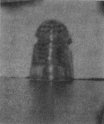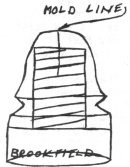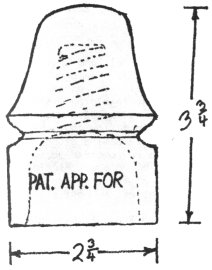Questions Answered by N. R. Woodward
Author of The Glass Insulator in America
Reprinted from "INSULATORS - Crown Jewels of the Wire", October 1973, page 4
Robert M. Hines of West Monroe, Louisiana writes: I have a CD 151 H G Co Patd
May 2nd 1893 Petticoat, ice or pale blue, which has small flat like drips on the
outer skirt and ROUND DRIPS on 1/2 of the inner skirt, and the other 1/2 is
perfectly smooth. I do not find any information on this in the various books I
have. It may have been described in Crown Jewels or OBX or others, but I failed
to notice it. It also may be very common in some areas. Any information you may
give will be appreciated.
- - - - - - -
In reply to Robert M. Hines: The mold in which your insulator was made was
the same as any other, with sharp drip points all around the inner skirt. When
there was not quite enough glass to fill the mold, as was often the case when
the glass was sheared by hand before automatic machinery, it was usually the
inner skirt of a double petticoat insulator where the shortage of glass showed
up. The glass would not press all the way into the sharp points, and would make
round drip points in a portion of the skirt, or, as in the case you describe,
completely fail to form the drip points in a large area.
Since most insulators do not have drip points on the inner skirt, this
condition usually shows up as a depression around a part of the rim. This is
quite common. I know of no special value being attached to it.
Question from Fred 0. Escher, Sun Prairie, Wisconsin: Enclosed is a picture
of an insulator I recently found. It measures 3-8/10" in height and
2-6/10" across the base. It is aqua and has no marking at all. Is this a CD
104? It is a nice looking insulator.

- - - - - - -
In reply to Fred 0. Escher: Yes--an unembossed CD #104. I've seen several of
these and have no idea where they came from. They look very much like Brookfield
glass.
C. Bullock of Waukegon, Illinois writes: I have #'s 1, 3, 4 of the set of
Brookfield beehives (short with a thick base) and am wondering about how much
they would be worth as a complete set. There doesn't seem to be too many around,
so are they scarce? I bought these three for $1.50 at an antique store in
Tennessee.
And Lew Hohn, Rochester, New York adds: Re the continuing interest and
reports on the B/4/4, etc. When we first started collecting insulators from old
lines a few years ago, we brought home everything we found, including a few
bushel baskets of "B" beehives. Recently decided to get rid of these
at a local flea market, and while going thru them we "found" the B/4/4
same as one I had traded for some time ago. Another showed up, along with the
B/3/dot and the B/1. Then picked up a couple more from another flea market, so
have 2 and 3 of each of these three. All from the same line in this area. Have
been watching for the B/2/2, but none so far. But feel there should be some
around, since the others did show. What kind of trade value do you put on these?
Enjoy very much your monthly addition to Crown Jewels.
- - - - - - - - -
In reply to C. Bullock and Lew Hohn: This set of "B" insulators has
aroused a surprising amount of interest, since as a general rule collectors have
ignored the variations in the "B" CD #145 except for the most unusual
colors. This style was a standard in general use for so many years that there
are several distinct mold sets. Probably the "B/4/4/", etc., set is
the least common, or one of the least common. I would not say that it is rare;
but will leave the suggestion of a specific trade value to those who publish
price guides.
Another very scarce "B" is the latest set. These are quite heavy
and have a very deep groove. The very latest of these have the No. 44 on the
opposite half-mold. These are also found with drip points, but I don't believe
one will be found with both drip points and No. 44, since Brookfield catalogued
the one with drip points as No. 45.
From Chris Seamons, Albuquerque, New Mexico: Since my family and I got home
from the show I've found that we have a CD 162 Ft. W. E. Co. with a patent date
on back and on the crown a Christian cross. The cross measures 1/2 in. tall and
1/4 in. wide. I would like to know if any other collectors have one and the
rarity of the insulator. I am 12 years old, and my family and I have been
collecting about two years.
- - - - - - - -
In reply to Chris Seamons: I have not seen the Ft. W. E. Co. insulator with a
marking on the crown. It is possible that the "cross" is a shop mark:
or it could be something left from previous engraving that was not completely
covered. There was at least one Brookfield mold of that period that had a very
large 24 on the crown. A portion of the 4 could form the cross, possibly, if
that mold had been re-engraved for making the Ft. W. E. Co. run. There is little
doubt that these insulators are a Brookfield product, since they exactly match
the Brookfields in every detail except the embossing.

Dee Willett, Bakersfield, California writes: This insulator is like CD 120
only smaller in every respect. F - on side of crown patent Dec. 19, 1871; F - on
skirt B; back side of crown 4. Ice blue. I believe this is the missing CD 118, 3
piece button mold. See what your research department can come up with attention
Mr. Woodward.
- - - - - - - -
In reply to Dee Willett: The insulator you have drawn is one of the CD
#124's. It is not related to CD #118. There are three variations of the CD
#124: the 124, 124.2 and 124.3. Until drawings are published It will be
difficult to be definite, but believe yours is a 124.3, the middle one of the
three styles in the evolution of the Hemingray No. 4.

From Jim Decker, Pleasanton, California: I recently found two insulators that
aren't listed in any of my insulator books and would like your help to identify
them. The first one is a glass bell insulator that I found in Oregon. See sketch
at left. Embossing on inside of first skirt: PYREX TM REG U.S. PAT OFF MADE IN
U.S.A. This insulator is light yellow and measures 6 inches across and 7 inches
long.

The second one is a Brookfield signal CD 133. See sketch. It is embossed as
follows: F - BROOKFIELD; B - NEW YORK. This insulator was made using the 3 part
mold, but has a mold line over the dome that extends half way down to the wire
groove. There's also a backwards 5 on the dome.
Any information that you may have on these insulators would be very helpful
to me.
- - - - - - -
In reply to Jim Decker: The Pyrex 6-inch suspension disc was a standard Item
in the Corning line, but they were never as common as the larger ones. Often
they were used on primary distribution lines for dead-ending and on corners,
with regular pin types used on other poles.
I have never seen one of the Shop Mark 5 CD #133 Brookfields that was made in
anything but the usual molds used during the "BROOKFIELD / NEW YORK"
period. Since you state that it appears to be a three-piece mold, I would
suspect that the line over the crown is a fold in the glass rather than a mold
line. If it is a fold, it would be slightly indented, rather than raised as is a
mold line. If it is a raised line, I would suspect a scratch in the mold
occurring during machining, rather than an entirely different mold. It is true
that there was some experimentation with two-piece molds nearly that late in the
game; but if it were that, the line would necessarily extend the full height of
the insulator.
Loren Donoho of Centralia, Illinois writes: I have a number of CD 162 - 164 -
HG one side, and PETTICOAT on the other, without drip points. Would like someone
to give me a price on them. Have not heard of them anywhere. Have peacock,
limes, aquas, clear, slight amethyst.
- - - - - - - -
In reply to Loren Donoho: Your H. G. CO. CD #162 and 164 with smooth skirt
are less common than those with drip points, and are generally older, although
some insulators were always being made with smooth skirts throughout the years
that drip points were made. According to your description, some of those you
have may be Covington production, which again does not necessarily pre-date
Muncie production, since both plants were in operation for some years. I would
not attempt to set a value on your insulators; but if you want to sell them, I
would suggest that you make them available to serious collectors, because,
although not extremely rare, they may well be very desirable Items.

From Dave Morgan, Mission Hills, California: I have recently obtained an
insulator of which I know nothing. I have enclosed a picture of this insulator.
Description: Dark blue, 3 piece mold, swirl start threads. I would greatly
appreciate any information that you or your readers could give me. Thank you for
your time.
- - - - - - - - -
In reply to Dave Morgan: Sorry, several of these insulators have been found,
but their origin is unknown!
Dan Thoma, Yakima, Washington asks: Could you help us on a few insulators? We
have one that is like a CD 202 Transposition. F-Locke Victor N.Y. B-No.14 over
Pat. May 22 1894. All we've seen say Fred M. Locke, etc. and 1884. The color is
deep aqua. Can't find the other one right now. But if you could, tell us about
worth, rarity, and if it is a CD 202. Thank you.
P.S. We have one that is like a CD 287, only the only marking it has is on
one side-- No. 15. The ones listed have Fred M Locke, etc. on the front. This
one has nothing but one swirl line. Aqua deep in color.
- - - - - - - -
In reply to Dan Thoma: CD #202 was one of the first insulators to be made
under the Locke name; and was to become one of their most popular units. The
engraving of molds went through an evolution along with the changes in the Locke
porcelain insulator business. All this is set forth in Jack Tod's book Porcelain
Insulators.
Earliest Locke units were lettered FRED M. LOCKE and did not at first carry a
style number. As you know, the May 22, 1894 date refers to a transposition
insulator: and while the drawing accompanying that patent does not correspond to
a CD #202, this was the most popular one-piece transposition for many years.
Later the "FRED M." was removed from the molds when the Locke
organization ceased to be known by the full name. And still later, possibly
after the units were no longer being made for Locke, Brookfield made some of the
styles with only the number. The exact dates for all of these changes cannot be
certain, since molds were not always re-engraved at once; but this is the
general sequence involved.
| 